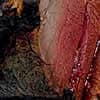View full lesson: http://ed.ted.com/lessons/how-the-foo…
Tag: food
Farming first
The Campaign for Food Justice Now
Prominent food researcher Patricia Allen finds promise in the movement, but also raises concerns about the effects of alternative economic strategies that are found in community supported agriculture (CSA) and farmers market models
and the possibility that these types of “designer” food production schemes may create a two-tiered food system built upon class differences.
She also critiques the movement’s view that using food assistance programs is “dependence,” pointing out that in antihunger perspectives food is viewed as a right to be fulfilled by the state if the market, or for us the self-reliant community, fails.
Published on Mar 4, 2013
LaDonna Redmond is the founder and executive director of The Campaign for Food Justice Now. Previously, she was part of the Institute for Agriculture and Trade Policy in 2011 as the Senior Program Associate in Food and Justice. A long-time community activist, she has successfully worked to get Chicago Public Schools to evaluate junk food, launched urban agriculture projects, started a community grocery store, and worked on federal farm policy to expand access to healthy food in low-income communities. In 2009, she was one of 25 citizen and business leaders named a Responsibility Pioneer by Time Magazine. In 2007, she was awarded a Green For All Fellowship. LaDonna was also a 2003-2005 IATP Food and Society Fellow. Redmond is a frequently invited speaker, and currently hosts the weekly Monday evening radio program “It’s Your Health” on 89.9 KMOJ, The People’s Station. LaDonna attended Antioch College in Yellow Springs, Ohio.
Accessing healthy food is a challenge for many Americans—particularly those living in low-income neighborhoods, communities of color, and rural areas.
A 2009 study by the U.S. Department of Agriculture found that 23.5 million people lack access to a supermarket within a mile of their home.
A recent multistate study found that low-income census tracts had half as many supermarkets as wealthy tracts. Another multistate study found that eight percent of African Americans live in a tract with a supermarket, compared to 31 percent of whites. And a nationwide analysis found there are 418 rural “food desert” counties where all residents live more than 10 miles from a supermarket or supercenter— this is 20 percent of rural counties.
Researchers find that residents who live near supermarkets or in areas where food markets selling fresh produce (supermarkets, grocery stores, farmers’ markets, etc.) outnumber food stores that generally do not (such as corner stores) have lower rates of diet-related diseases than their counterparts in neighborhoods lacking food access.
Different foods require radically different amounts of water
Different foods require radically different amounts of water. To grow a kilogram of wheat requires around 1,000 litres. But it takes as much as 15,000 litres of water to produce a kilo of beef. The meaty diet of Americans and Europeans requires around 5,000 litres of water a day to produce. The vegetarian diets of Africa and Asia use about 2,000 litres a day (for comparison, Westerners use just 100-250 litres a day in drinking and washing).
So the shift from vegetarian diets to meaty ones—which contributed to the food-price rise of 2007-08—has big implications for water, too. In 1985 Chinese people ate, on average, 20kg of meat; this year, they will eat around 50kg. This difference translates into 390km3 (1km3 is 1 trillion litres) of water—almost as much as total water use in Europe.
The shift of diet will be impossible to reverse since it is a product of rising wealth and urbanisation. In general, “water intensity” in food increases fastest as people begin to climb out of poverty, because that is when they start eating more meat. So if living standards in the poorest countries start to rise again, water use is likely to soar. Moreover, almost all the 2 billion people who will be added to the world’s population between now and 2030 are going to be third-world city dwellers—and city people use more water than rural folk.
The environmental impact of meat production varies because of the wide variety of agricultural practices employed around the world. All agriculture practices have been found to have a variety of effects on the environment. Some of the environmental effects that have been associated with meat production are pollution through fossil fuel usage, and water and land consumption. Meat is obtained through a variety of methods, including organic farming, free range farming, intensive livestock production, subsistence agriculture, hunting and fishing. As part of the conclusion to one of the largest international assessments of animal agriculture ever undertaken, the Food and Agriculture Organisation of the United Nations said:
The livestock sector is a major stressor on many ecosystems and on the planet as a whole. Globally it is one of the largest sources of greenhouse gasses and one of the leading causal factors in the loss of biodiversity, while in developed and emerging countries it is perhaps the leading source of water pollution.
Can food really be as addictive as drugs?
Can Food Really Be Addictive? Yes, Says National Drug Expert
Compare the proportion of obese people in America to those who are addicted to drugs and then try to argue that food isn’t as addictive as crack cocaine, says Dr. Nora Volkow, the director of the National Institute on Drug Abuse.
Can food really be as addictive as drugs? In an impassioned lecture at Rockefeller University on Wednesday, Dr. Nora Volkow, director of the National Institute on Drug Abuse, made the case that the answer is yes and that understanding the commonalities between food and drug addictions could offer insights into all types of compulsive behavior.
Many of the neural signals involved in addictive behaviour also appear to be active in food reward. Naturally occurring opioids in the brain (including endorphins, enkephalins, dynorphins, and endomorphins) play an important role in neural reward processes that can lead to addictive behaviour. Both homeostatic and reward-based feeding mechanisms involve opioid peptide systems and opioid receptors, and opioid receptor blockers (antagonists) inhibit consumption of both addictive drugs and palatable food. Clinical trials targeting opioid receptors have revealed weight loss potential for opioid antagonists in obese patients. These relationships suggest the existence of a form of opioid-related addiction focused on palatable foods, although there are still major gaps in our knowledge of the molecular mechanisms through which opioids influence the hedonic properties of food.
Toward a Healthy Sustainable Food System
Date: Nov 06 2007Policy Number: 200712
Key Words: Climate Change, Food Security, Obesity, Occupational Health And Safety, Food
Purpose
In the United States, obesity and diet-related chronic disease rates are escalating, while the public’s health is further threatened by rising antibiotic resistance; chemicals and pathogens contaminating our food, air, soil and water; depletion of natural resources; and climate change. These threats have enormous human, social, and economic costs that are growing, cumulative, and unequally distributed. These issues are all related to food—what we eat and how it is produced. The US industrial food system provides plentiful, relatively inexpensive food, but much of it is unhealthy, and the system is not sustainable. Although most US food consumption occurs within this industrial system, healthier and more sustainable alternatives are increasingly available.
The American Public Health Association (APHA) has long been active on food system issues, as is shown by the large body of relevant policy. Moving toward a healthier and more sustainable food system will involve tackling longstanding challenges and addressing new and evolving demands. This position paper reviews the scientific basis for understanding the US food system and sustainability, identifies specific issues of concern, discusses key related policies and action opportunities, and outlines APHA goals. By uniting multiple food system themes in a single statement, it aims to provide clarity, new emphases, and solid direction, encouraging the APHA to increase its activities and leadership to promote a more sustainable, healthier, and more equitable food system.
Cobalamin (Vitamin B-12)
Vitamin B-12, or Cobalamin, is the largest and most complex vitamin currently known to man. A slight deficiency of vitamin B-12 can lead to anemia, fatigue, mania, and depression, while a long term deficiency can cause permanent damage to the brain and central nervous system. Vitamin B12 can only be manufactured by bacteria and can only be found naturally in animal products, however, synthetic forms are widely available and added to many foods like cereals. Vitamin B12 can be consumed in large doses because excess is excreted by the body or stored in the liver for use when supplies are scarce. Stores of B12 can last for up to a year. Below are the top 10 foods highest in vitamin B12 by common serving sizes, click here for high vitamin B12 foods by nutrient density, here for an extended list of vitamin B12 rich foods, and here for other foods high in vitamin B. For even more see the articles for vegan and vegetarian sources of vitamin B12.

#1: Shellfish (Cooked Clams)
| Vitamin B12 in 100g | 3oz Serving (85g) | Per 20 small clams (190g) |
| 98.9μg (1648% DV) | 84.1μg (1401% DV) | 187.9μg (3132% DV) |
Other Shellfish High in Vitamin B12 (%DV per 3oz serving cooked): Oysters (408%), and Mussels (340%). Click to see complete nutrition facts.
#2: Liver (Beef)
| Vitamin B12 in 100g | 3oz Serving (85g) | Per Slice (81g) |
| 83.1μg (1386% DV) | 70.7μg (1178% DV) | 67.3μg (1122% DV) |
Other Liver Products High in Vitamin B12 (%DV per 3oz serving): Liverwurst Sausage (189%), Paté de Foie Gras (133%) and Chicken Liver Paté (114%). Click to see complete nutrition facts.

#3: Fish (Mackerel)
| Vitamin B12 in 100g | 3oz Serving (85g) | Per Fillet (88g) |
| 19.0μg (317% DV) | 16.2μg (269% DV) | 16.7μg (279% DV) |
Other Fish High in Vitamin B12 (%DV per 3oz serving cooked): Smoked Salmon (257%), Herring (186%), Tuna (154%), Canned Sardines (126%) and Trout (106%). Click to see complete nutrition facts. For more see the article on Canned Fish High in Vitamin B12.

#4: Crustaceans (Crab)
| Vitamin B12 in 100g | 3oz Serving (85g) | Per Leg (134g) |
| 11.5μg (192% DV) | 9.8μg (163% DV) | 15.4μg (257% DV) |
Other Crustaceans High in Vitamin B12 (%DV per 3oz serving cooked): Crayfish (44%), Shrimp (24%) and Lobster (20%). Click to see complete nutrition facts.

#5: Fortified Soy Products (Silken Tofu)
| Vitamin B12 in 100g | 3oz Serving (85g) | Per 1/5 package (91g) |
| 2.4μg (40% DV) | 2.0μg (34% DV) | 2.2μg (37% DV) |
Light Plain Soymilk contains (50% DV) of Vitamin B12 per cup. Click to see complete nutrition facts.
#6: Fortified Cereals (All Bran)
| Vitamin B12 in 100g | Per Cup (90g) | Per Serving(1/3 Cup – 30g) |
| 20.0μg (333% DV) | 18.0μg (300% DV) | 6.0μg (100% DV) |
Click to see complete nutrition facts. For more see the article on Cereals High in B12.
#7: Red Meat (Beef)
| Vitamin B12 in 100g | 3oz Serving (85g) | Per Medallion (34g) |
| 6.0μg (100% DV) | 5.1μg (85% DV) | 2.0μg (34% DV) |
Lamb is also High in Vitamin B12 with (45% DV) per 3oz serving cooked. Click to see complete nutrition facts.

#8: Low Fat Dairy (Skim Milk)
| Vitamin B12 in 100g | Per Cup (245g) | Per Quart (980g) |
| 0.5μg (8% DV) | 1.2μg (21% DV) | 4.9μg (82% DV) |
Other Dairy Foods High in Vitamin B12 (%DV per cup): Nonfat Yogurt (25%), Reduced Fat Milk (22%), Whole Milk (18%), and Full Fat Yogurt (15%). Click to see complete nutrition facts.

#9: Cheese (Swiss)
| Vitamin B12 in 100g | 1oz Serving (28g) | Per Cup Shredded (108g) |
| 3.3μg (56% DV) | 0.9μg (16% DV) | 3.6μg (60% DV) |
Other Cheeses High in Vitamin B12 (%DV per 1 oz serving): Reduced Fat Mozzarella, Parmesan and Gietost (11%), Tilsit (10%) and Feta (8%). Click to see complete nutrition facts.

#10: Eggs (Chicken’s)
| Vitamin B12 in 100g (Yolk) | Per Yolk (17g) | Per Whole Egg (50g) |
| 2.0μg (33% DV) | 0.3μg (6% DV) | 0.36μg (6% DV) |
Other Eggs High in Vitamin B12 (%DV per whole egg, raw): Goose (122%), Duck (63%), Turkey (22%), and Quail (2%). Click to see complete nutrition facts.
Read more at http://www.healthaliciousness.com/articles/foods-high-in-vitamin-B12.php#c1AIjCshFSfqQVHv.99
Conscious Eating
Conscious Eating has been referred to as the “Bible of Vegetarians,” for both beginners and advanced students of health. This classic work in the field of live-food nutrition is an inspirational journey and a manual for life. Included is new information on enzymes, vegetarian nutrition for pregnancy, and an innovative international 14-day menu of gourmet, Kosher, vegetarian, live-food cuisine, plus 150 recipes.
Published on Nov 20, 2012
What has your food been eating?
What has your food been eating?
Laurent Adamowicz at TEDxBeaconStreet
Published on Mar 18, 2013
Having seen the very best, the worst, and the ugliest of the food industry, Laurent Adamowicz gives a poignant account of how our food system has dramatically changed over the last two decades. Could the obesity epidemic be directly linked to what our food has been eating?
Senior Fellow 2011 in the Advanced Leadership Initiative at Harvard University, Laurent Adamowicz is a former food industry executive and serial entrepreneur. He is the founder & CEO of Bon’App, a simple nutrition guidance mobile application that tells you what’s in your food.
In the spirit of ideas worth spreading, TEDx is a program of local, self-organized events that bring people together to share a TED-like experience. At a TEDx event, TEDTalks video and live speakers combine to spark deep discussion and connection in a small group. These local, self-organized events are branded TEDx, where x = independently organized TED event. The TED Conference provides general guidance for the TEDx program, but individual TEDx events are self-organized.* (*Subject to certain rules and regulations)
Save food from the fridge
Save food from the fridge: Shaping traditional oral knowledge: Jihyun Ryou at TEDxEutropolis
Uploaded on Feb 9, 2012
Although we seem to think and talk about food almost constantly, do we really know how best to preserve it or do we leave this responsibility to technology? Design Academy Eindhoven graduate Jihyun Ryou feels we no longer understand how to treat food. After investigating how to preserve food through oral traditions, she was determined to find designfull solutions on how to survive without fridge nowadays. Her Save Food from the Fridge project involves placing certain foods on a group of “knowledge shelves” outside the fridge. Perhaps through a better relationship with our food we may be able to waste less and conserve more energy.


